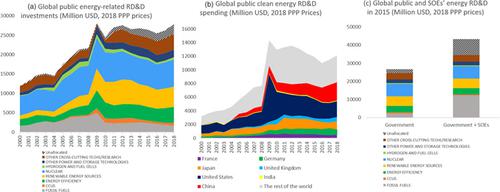当前位置:
X-MOL 学术
›
WIREs Clim. Chang.
›
论文详情
Our official English website, www.x-mol.net, welcomes your feedback! (Note: you will need to create a separate account there.)
From fossil to low carbon: The evolution of global public energy innovation
WIREs Climate Change ( IF 9.2 ) Pub Date : 2021-08-17 , DOI: 10.1002/wcc.734 Fang Zhang 1, 2, 3 , Kelly Sims Gallagher 2 , Zdenka Myslikova 2 , Easwaran Narassimhan 2 , Rishikesh Ram Bhandary 2 , Ping Huang 4
WIREs Climate Change ( IF 9.2 ) Pub Date : 2021-08-17 , DOI: 10.1002/wcc.734 Fang Zhang 1, 2, 3 , Kelly Sims Gallagher 2 , Zdenka Myslikova 2 , Easwaran Narassimhan 2 , Rishikesh Ram Bhandary 2 , Ping Huang 4
Affiliation

|
A review of global and national energy research, development, and demonstration (RD&D) investments between 2000 and 2018 reveals that global public energy RD&D and cleaner energy RD&D investments dramatically increased, but then plateaued after 2009. In absolute values, nuclear energy has held steady, fossil energy contracted, and clean energy RD&D quadrupled. As a percentage of overall investments, both fossil fuel and nuclear investments contracted during the period. This review compares the energy innovation priorities of the world's largest economies using the metric of public expenditures on energy RD&D. China and India have become important global public investors in energy innovation, now among the top five globally. Priorities set by the Chinese and Indian governments will thus influence new energy technology breakthroughs in the coming years. The US and Chinese governments are now competing for first place in clean energy RD&D, depending on whether or not nuclear and cross-cutting technologies are included. India has dedicated substantial funding to indigenizing nuclear power technologies. Energy RD&D by state-owned enterprises (SOEs) in major emerging economies remains skewed toward fossil fuels and nuclear. Reforming SOE expenditures to move away from fossil fuels could have a major impact on global energy technology trajectories, making a material difference in the quest to decarbonize the energy system.
更新日期:2021-10-15



























 京公网安备 11010802027423号
京公网安备 11010802027423号